AUDI S3 SEDAN 2015 Owners Manual
Manufacturer: AUDI, Model Year: 2015, Model line: S3 SEDAN, Model: AUDI S3 SEDAN 2015Pages: 282, PDF Size: 71.14 MB
Page 141 of 282
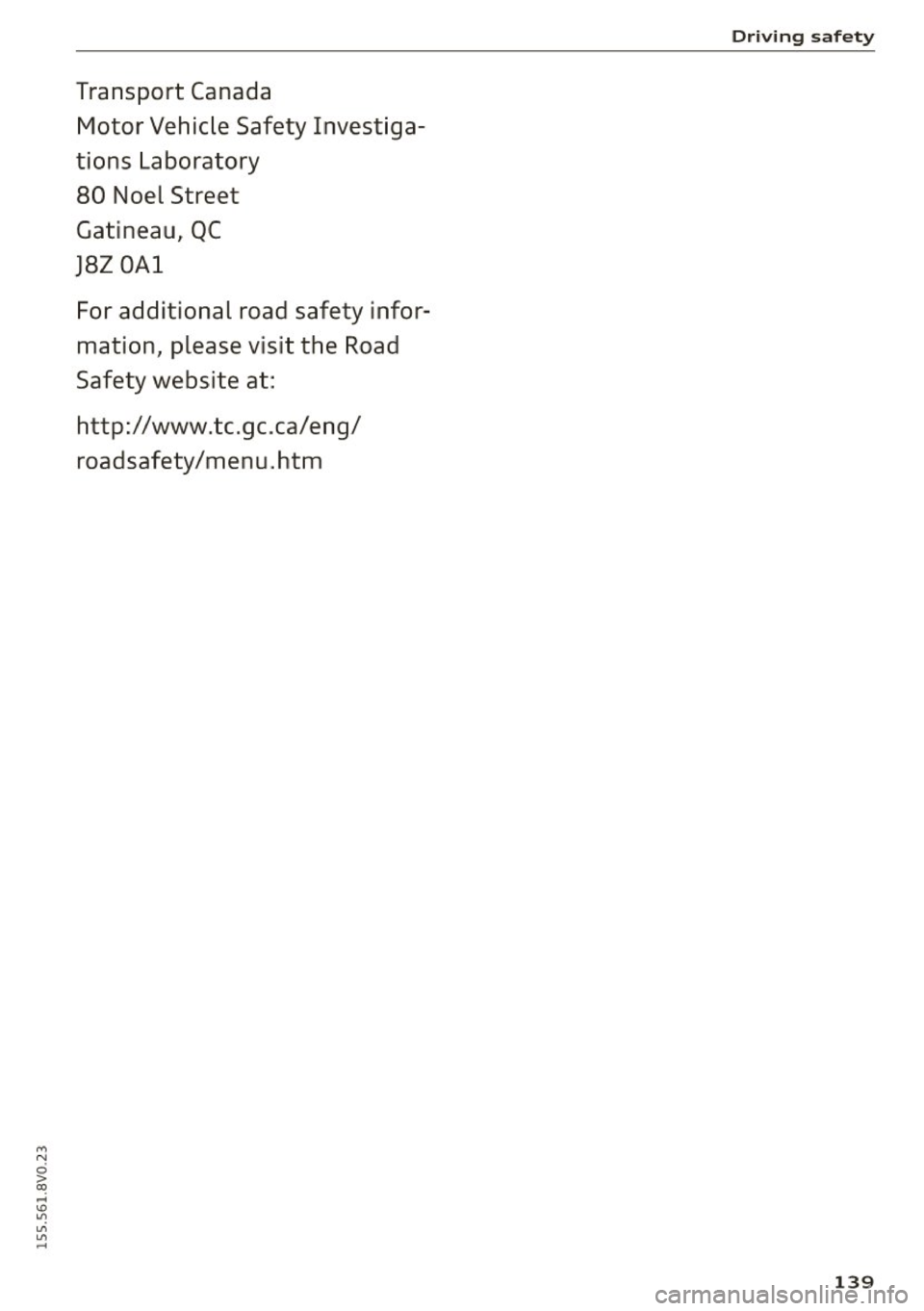
Transport Canada Motor Vehicle Safety Investiga
tions Laboratory
80 Noel Street
Gatineau, QC
J8Z OA l
For additional road safety infor
mation, please visit the Road
Safety website at:
http://www.tc.gc .ca/eng/
roadsafety/menu.htm
Dr iv ing safety
1 39
Page 142 of 282
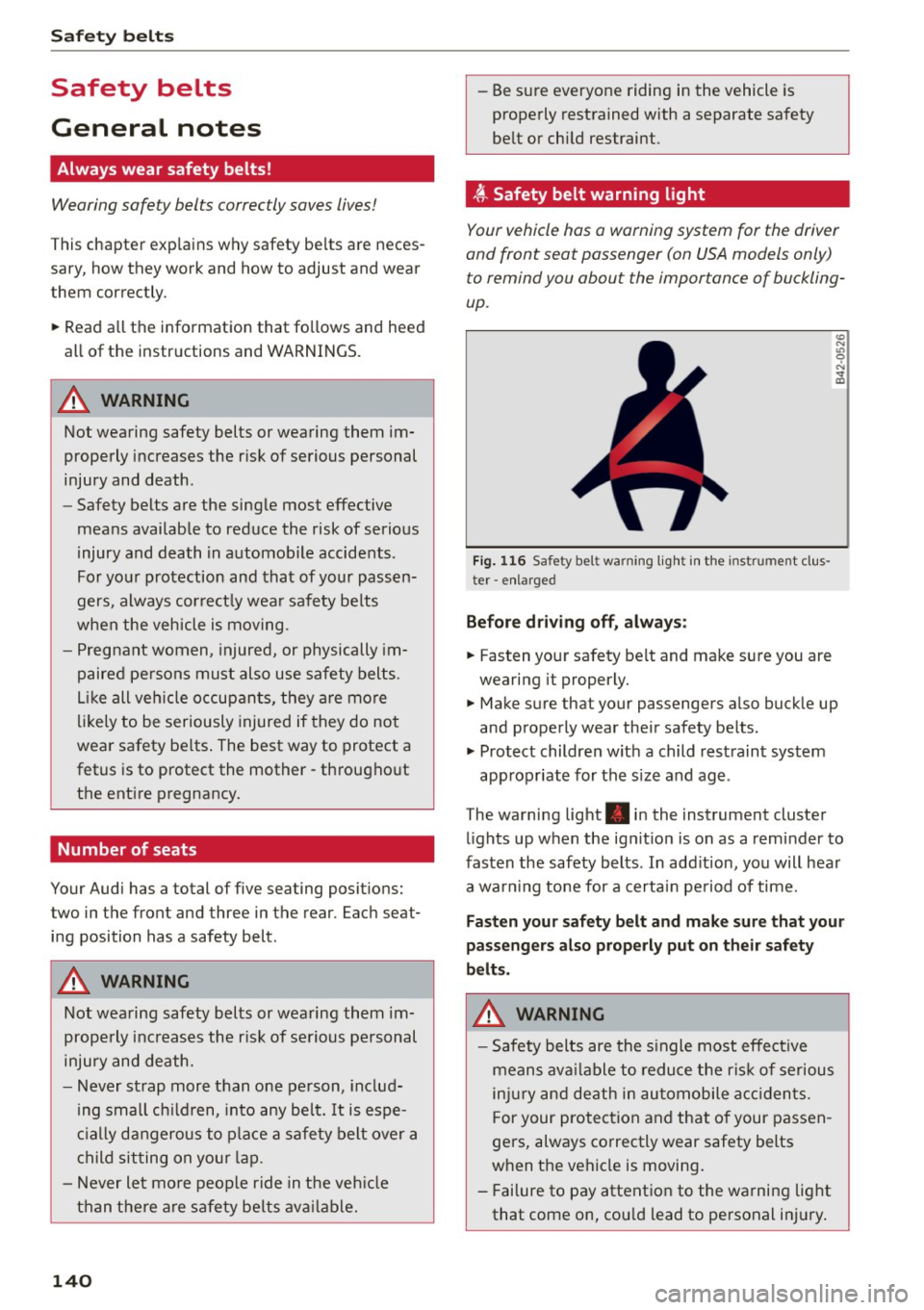
Safety belt s
Safety belts
General notes
Always wear safety belts!
Wearing safety belts correctly saves lives!
This chapter explains why safety belts are neces
sary, how they work and how to adjust and wear
them correctly.
.. Read all the information that follows and heed
all of the instructions and WARNINGS.
&_ WARNING
Not wearing safety belts or wearing them im
properly increases the risk of serious personal
injury and death.
- Safety belts are the single most effective
means available to reduce the risk of serious
injury and death in automobile accidents.
For your protection and that of your passen
gers, always correct ly wear safety belts
when the vehicle is moving.
- Pregnant women, injured, or physically im
paired persons must also use safety belts.
L ik e all veh icle occupants, they are more
likely to be seriously injured if they do not
wear safety be lts . The best way to protect a
fetus is to protect the mother - throughout
the ent ire pregnancy.
Number of seats
Your Audi has a total of five seating positions:
two in the front and three in the rear. Each seat
ing position has a safety belt .
&_ WARNING
Not wearing safety belts or wearing them im
properly increases the risk of serious personal
injury and death.
- Never strap more than one person, includ
ing small ch ildren, into any belt. It is espe
cially dangerous to place a safety belt over a
child sitting on your lap.
- Never let more people ride in the vehicle
than there are safety belts available.
140
-Be sure everyone riding in the vehicle is
properly restrained with a separate safety
belt or child restraint.
~ -Safety belt warning light
Your vehicle has a warning system for the driver
and front seat passenger (on USA models only) to remind you about the importance of buckling
up .
Fig. 116 Safety belt warning light in the instrument cl us
ter -enlarged
Before driving off, always:
.. Fas ten your safety belt and make sure you are
wearing it properly .
(0
"'
"' 9
"'
and properly wear their safety belts .
.. Protect children with a child restraint system
appropriate for the s ize and age .
The warning light . in the instrument cluster
light s up when the ign it ion is on as a reminder to
fasten the safety belts . In add ition, you will hear
a warn ing tone for a certain pe riod of time.
Fasten your safety belt and make sure that your
passengers also properly put on their safety
belts .
&_ WARNING
-Safety belts are the sin gle most effect ive
means available to reduce the risk of serious
injury and death in automobile accidents.
F or your protection and that of your passen
gers, always correctly wear safety belts
when the vehicle is moving .
- Failure to pay attention to the warning light
that come on, cou ld lead to personal injury .
-
Page 143 of 282

....,
N
0 > co
rl I.O
"'
"'
"'
rl
Why use safety belts?
Frontal collisions and the law of physics
Frontal crashes create very strong forces for peo
ple riding in vehicles .
Fig. 117 Unbelted occupants in a ve hicle heading for a wall
Fig . 118 The vehicle cras hes into th e wall
CD
~ ±
cle and the passengers possess energy which var ies with vehicle speed and body weight . Engi
neers call this energy "kinetic energy."
The higher the speed of the vehicle and the
greater the vehicle's weight, the more energy
that has to be "absorbed" in the crash.
Vehicle speed is the most significant factor. If the
speed doubles from 15 to 30 mph (25 to 50 km/
h) , the energy increases 4 times!
Because the passengers of this vehicle are not us
ing safety belts
q fig. 117, they will keep moving
at the same speed the vehicle was moving just
before the crash, until something stops them -
here, the wall
qfig. 118 .
The same principles apply to people sitting in a
vehicle that is involved in a frontal collision. Even
at city speeds of 20 to 30 mph (30 to 50 km/h),
the forces acting on the body can reach one ton
Safety belts
(2,000 lbs, or 1,000 kg) or more . At greater
speeds, these forces are even higher .
People who do not use safety belts are also not
attached to their vehicle. In a frontal collision
they will also keep moving forward at the speed
their vehicle was travelling just before the crash.
Of course, the laws of physics don't just apply to
frontal collisions, they determ ine what happens
in all kinds of accidents and collisions.
What happens to occupants not wearing
safety belts?
In crashes unbelted occupants cannot stop themselves from flying forward and being in
jured or killed . Always wear your safety belts!
Fig. 119 A dr iver not wea ring a safety belt is vio lently
thrown forward
Fig. 120 A rear passenger not wearing a sa fety belt w ill fly
fo rward and strike t he drive r
Unbelted occupants are not able to resist the tre
mendous forces of impact by holding tight or
bracing themselves . Without the benefit of safe
ty restraint systems, the unrestrained occupant
will slam v iolently into the steering wheel, in
strument panel, windshie ld, or whatever else is
in the way
q fig . 119 . This impact with the vehi
cle interior has all the energy they had just before
the crash. ..,_
141
Page 144 of 282
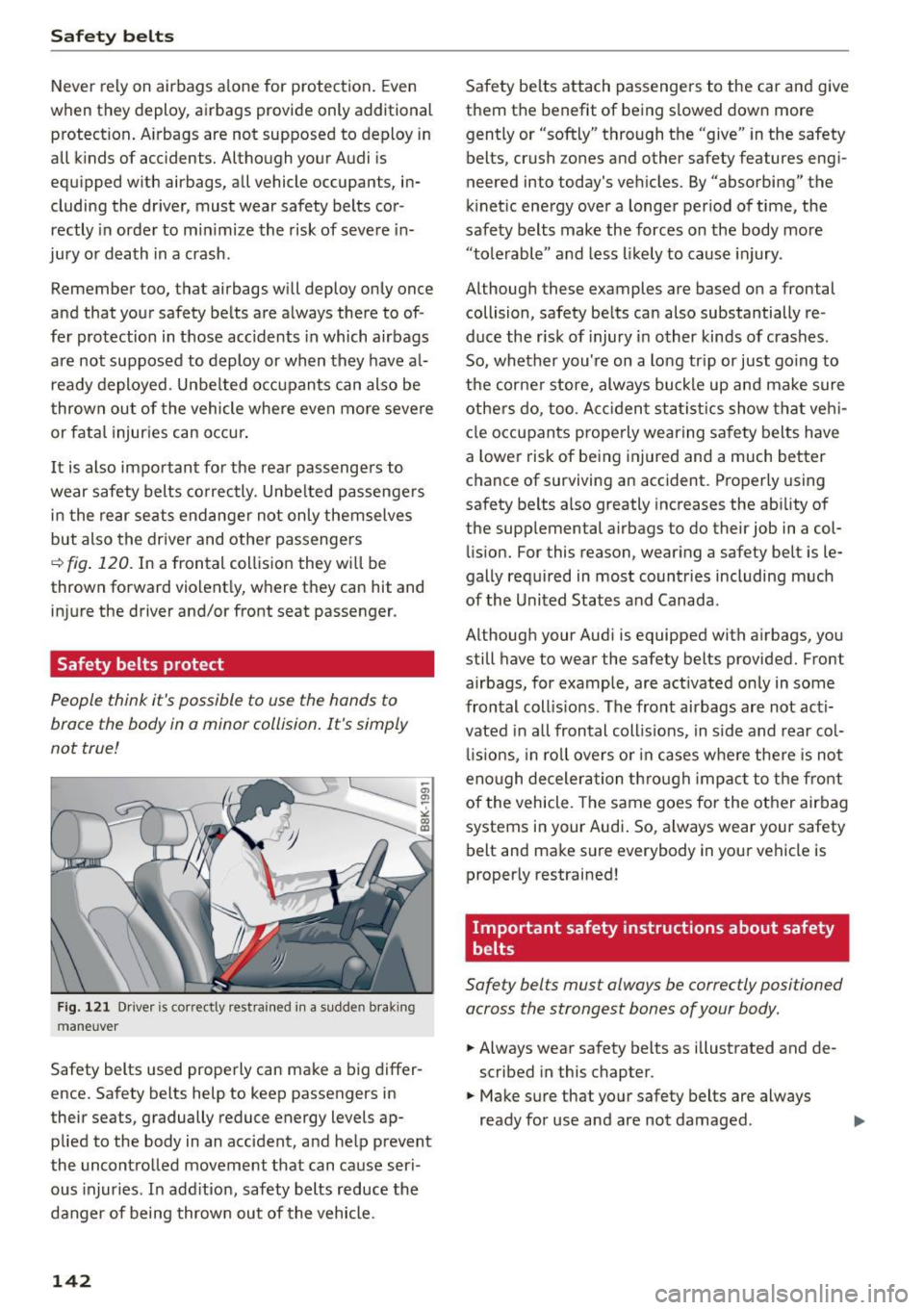
Safety belts
Never rely on airbags a lone for protection . Even
when they deploy, airbags provide only additional
protection . A irbags are not supposed to deploy in
all kinds of accidents. Although your Audi is
equipped w ith airbags, all vehicle occupants, in
cluding the driver, must wear safety belts cor
rectly in orde r to min imize the risk of seve re in
jury o r death in a crash .
Remember too, that airbags will deploy only once
and that your safety be lts are a lways there to of
fer protection in t hose accidents in which airbags
are not supposed to deploy or when they have a l
ready deployed . Unbelted o ccupan ts can also be
thrown ou t of the vehicle where even mo re severe
or fata l injur ies can occur .
It is also important fo r the rea r passenge rs to
wear safety belts co rrectly. Unbe lted passenge rs
i n t he rear se ats endanger not only themselves
but also the driver and other passengers
~ fig . 120. In a frontal coll ision they wi ll be
thrown forward violent ly, where they can hit and
in ju re the driver and/or front seat passenger.
Safety belts protect
People think it's possible to use the hands to
brace the body in a minor collision . It 's simply
not true!
F ig . 121 Driver is correct ly restra ined i n a sudden b rak ing
m aneuver
Safety belts used properly can make a big differ
ence. Safety belts help to keep passengers in
their seats , gradually reduce energy levels ap
plied to the body in an accident, and he lp prevent
the uncont ro lled movement that can cause seri
ous injur ies. In add it ion, safety belts reduce the
danger of being throw n ou t of the vehicle.
142
Safety be lts attach passengers to the car and give
them the benefit of being s lowed down more
gently or "softly" through the "give" in the safety
belts, crush zones and other safety features eng i
neered into today's veh icles. By "absorbing" the
ki net ic ene rgy over a longer period of time, the
safety be lts make the forces on the body more
"tole rable" and less li kely to cause injury .
Although these examples are based o n a frontal
collision, safety be lts can also substantially re
duce the r isk o f injury in other kinds o f crashes.
So, whether you're on a long tr ip or just go ing to
t he cor ne r store, always bu ckle up and ma ke sure
o thers do, too. Ac ciden t sta tis tics show that ve hi
cle occupants properly wearing sa fe ty belts have
a lowe r risk of be ing injured and a much better
chance of surviving an accident. Pro perly using
safety belts a lso greatly increases the ab ility of
the supp lemental airbags to do their job in a col
li sion. For this reason, wear ing a safety be lt is le
gally required in most countries including much
of the United States and Canada .
Although your Audi is equipped with a irbags, you
still have to wear the safety belts provided. Front airbags, for example, are act ivated only in some
fron tal coll is io ns . The front airbags are not act i
vated in a ll frontal col lisions, in s ide and rear co l
li sio ns, in ro ll overs o r in cases whe re the re is not
eno ugh deceler ation th rough impac t to the front
of the vehicle . T he same goes for the other airbag
systems in your Audi. So, always wear your safety
belt and make sure everybody in your vehicle is
proper ly restrained!
Important safety instructions about safety
belts
Safety belts must always be correctly positioned
across the strongest bones of your body .
.,. Always wear safety belts as illustrated and de
scribed in this chapter .
.,. Make s ure that your safety belts are always
ready fo r use and are not damaged .
Page 145 of 282
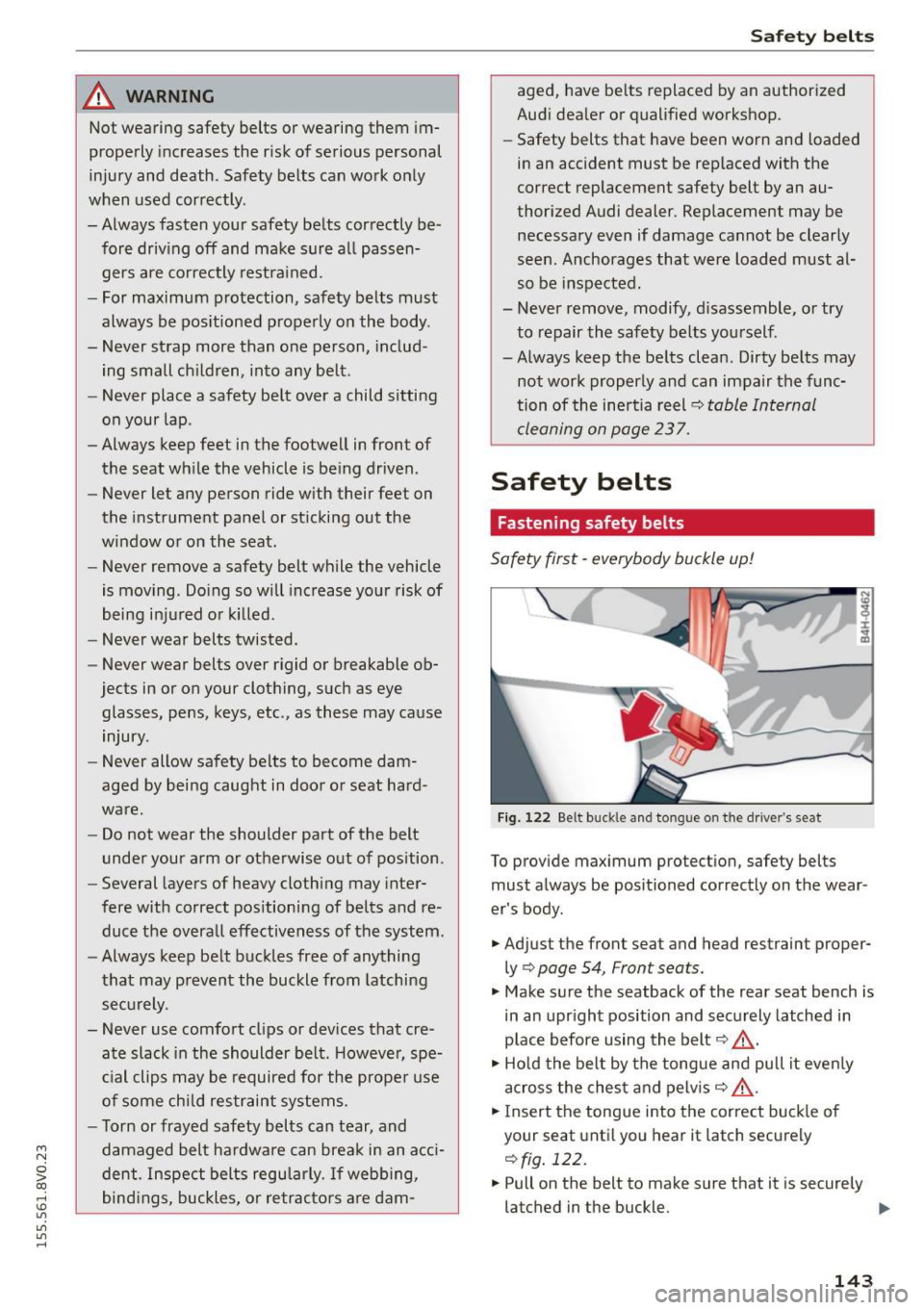
....,
N
0 > C() rl I.O
"'
"'
"'
rl
_& WARNING
Not wearing safety belts or wearing them im
properly increases the risk of serious personal
injury and death. Safety belts can work only
when used correctly .
- Always fasten your safety belts correctly be
fore driving off and make sure al l passen
gers are correctly restrained.
- For maximum protection, safety belts must
always be pos itioned properly on the body.
- Never strap more than one person, includ
ing small ch ildren, into any belt.
- Never place a safety belt over a child sitting
on your lap.
- Always keep feet in the footwell in front of
the seat while the vehicle is being driven.
- Never let any person ride with their feet on
the instrument panel or sticking out the
window or on the seat.
- Never remove a safety belt while the vehicle
is moving . Doing so will increase your risk of
being injured or killed.
- Never wear belts twisted.
- Never wear belts over rigid or breakable ob-
jects in or on your clothing, such as eye
glasses, pens, keys, etc., as these may cause
injury.
- Never allow safety belts to become dam
aged by being caught in door or seat hard
ware.
- Do not wear the shoulder part of the belt
under your arm or otherwise out of position.
- Several layers of heavy clothing may inter
fere with correct positioning of belts and re duce the overall effectiveness of the system.
- Always keep belt buckles free of anything
that may prevent the buckle from latching
securely.
- Never use comfort clips or devices that cre
ate slack in the shoulder be lt. However, spe
cial clips may be required for the proper use
of some child restraint systems.
- Torn or frayed safety belts can tear, and
damaged belt hardware can break in an acc i
dent. Inspect belts regularly. If webb ing,
bind ings, buckles, or retracto rs are dam-
Safety belts
aged, have belts replaced by an authorized
Audi dealer or qualified workshop.
- Safety belts that have been worn and loaded
in an accident must be replaced with the
correct replacement safety belt by an au
thorized Audi dealer. Replacement may be
necessary even if damage cannot be clearly
seen. Anchorages that were loaded must al
so be inspected.
- Never remove, modify, d isassemble, o r try
to repair the safety belts yourself.
-Always keep the belts clean. Dirty belts may not work properly and can impair the func
tion of the inertia reel~
table Internal
cleaning on page 237.
Safety belts
Fastening safety belts
Safety first -everybody buckle up!
Fig. 122 Belt buck le and tongue on the d rive r's seat
To provide maximum protection, safety belts
must always be positioned correctly on the wear
er's body.
.. Adjust the front seat and head restraint proper
ly ¢
page 54, Front seats.
.. Make sure the seatback of the rear seat bench is
in an upright position and securely latched in
place before using the belt¢.&, .
.. Ho ld the belt by the tongue and pull it even ly
across the chest and pelvis ¢.&_ .
.. Insert the tongue into the correct buckle of
your seat until you hear it latch securely
¢ fig. 122 .
.. Pull on the belt to make sure that it is securely
latched in the buckle.
Ill>
143
Page 146 of 282
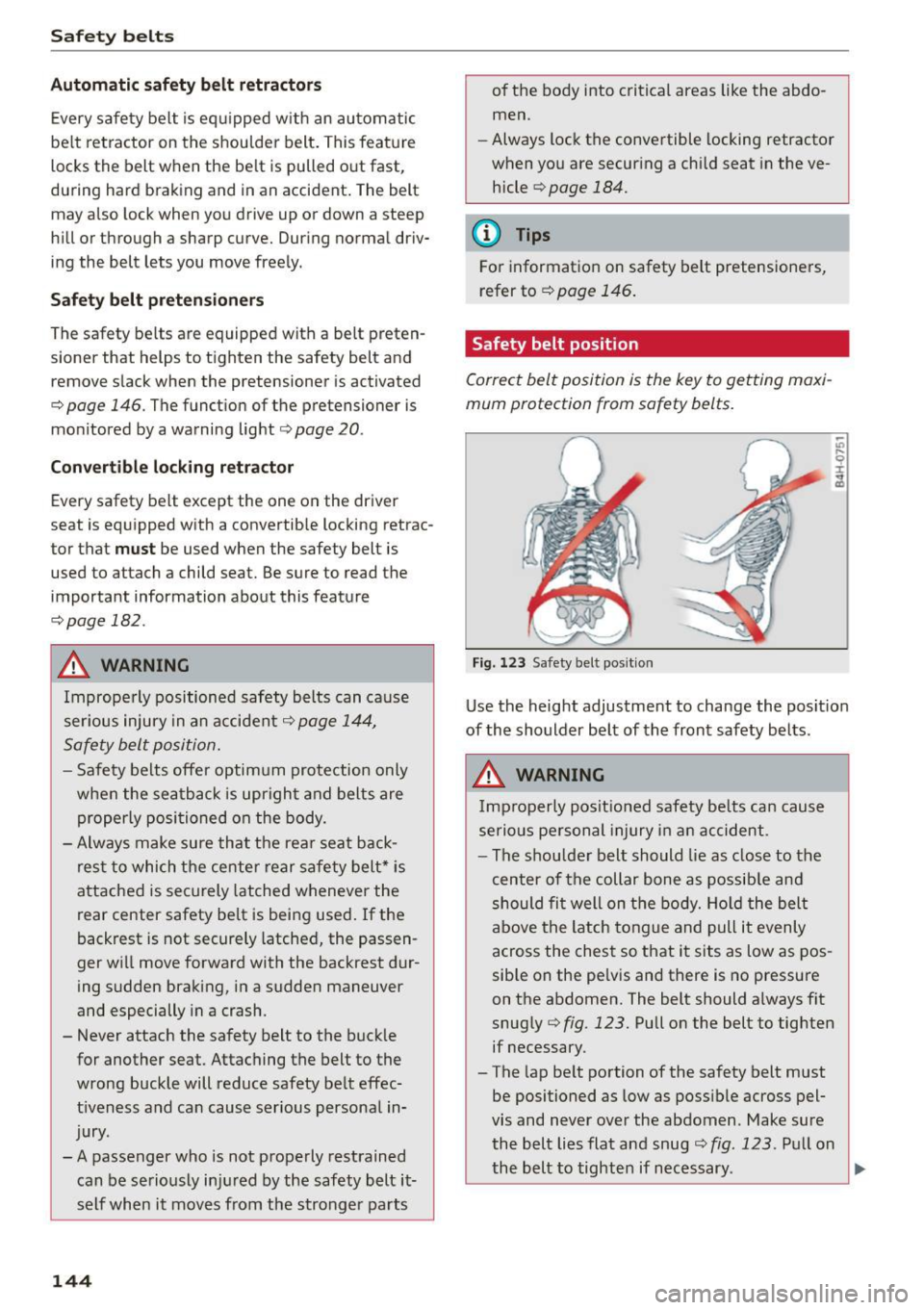
Safety belts
Autom atic safet y belt retractors
Every safety belt is eq uipped w ith an automatic
be lt retractor on the shou lder belt. This feature
locks the belt when the be lt is pulled o ut fast,
during hard brak ing and in an accident . The belt
may also lock when you drive up or down a steep
hill or through a sharp curve. During normal driv
ing the belt lets you move freely.
S afety belt p rete n sioner s
The safety be lts are equipped with a belt preten
sioner that helps to t ighten the safety belt and
remove s lack when the pretensioner is activated
¢ page 146. The funct ion of the pretensioner is
mon itored by a warning light
<=:>page 20.
Converti ble lock ing r etra ctor
Every safety belt except the one on the driver
seat is equipped w ith a convertib le locking retrac
tor that
must be used when the safety belt is
used to attach a child seat. Be sure to read the
important information about this feature
¢page 182 .
.&_ WARNING
Improperly positioned safety belts can cause
serious injury in an accident¢
page 144,
Safety belt posi tion.
- Safety belts offer optimum protection only
when the seatback is upright and belts are
properly positioned on the body.
- Always make sure that the rea r seat back
rest to which t he center rear safety belt* is
attached is securely latched whenever the
rear center safety be lt is being used .
If the
backrest is not securely latched, the passen
ger wi ll move forward with the backrest dur
ing sudden braking, in a sudden maneuver
and especially in a crash.
- Never attach the safety belt to the buck le
for another seat. Attaching the belt to the
wrong buckle will reduce safety be lt effec
t iveness and can cause serious persona l in
jury.
- A passenger who is not properly restrained can be se riously in jured by the safety belt it
self when it moves from the stronger parts
144
of the body into critical areas like the abdo
men.
- Always lock the convertible locking retractor
when you are secur ing a child seat in the ve
hicle
¢page 184.
(D Tips
For information on safety belt pretensioners,
refer to
¢page 146.
Safety belt position
Correct belt position is the key to getting maxi
mum protection from safety belts .
Fig. 123 Safety belt posit ion
Use the height adjustment to change the posit ion
of the shoulder belt of the front safety belts.
.&_ WARNING
I mp roperly posit ioned safety be lts can cause
serio us pe rsonal injury in an accident.
- The shou lder belt should lie as close to the
center of the collar bone as possib le and
should fi t well on the body. Ho ld the bel t
above the latch to ng ue and pull it evenly
across the chest so that it sits as low as pos
sible on the pe lvis and there is no pressure
on the abdomen. The belt should always fit
snug ly¢
fig. 123. Pull on the belt to tighten
if necessary.
- The lap be lt portion of the safety belt must
be positioned as low as poss ible across pel
vis and never over the abdomen. Make sure
the belt lies flat and snug
c::> fig. 123. Pu ll on
the belt to tighten if necessary.
~
Page 147 of 282
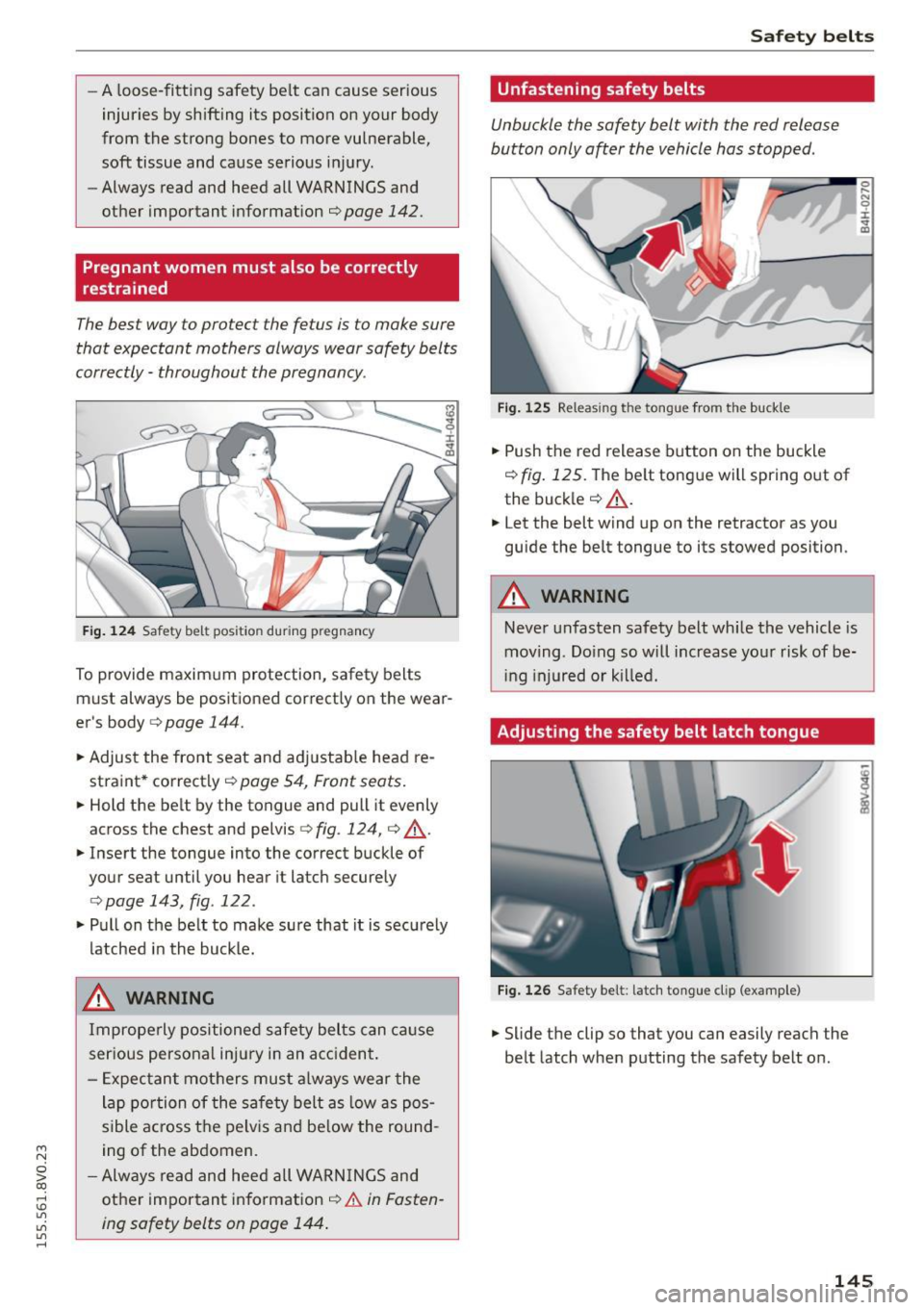
....,
N
0 > co
rl I.O
"'
"'
"'
rl
-A loose-fitting safety belt can cause serious
injuries by shifting its position on your body
from the strong bones to more vulnerable,
soft tissue and cause serious injury.
- Always read and heed all WARNINGS and
other important information ¢
page 142.
Pregnant women must also be correctly
restrained
The best way to protect the fetus is to make sure
that expectant mothers always wear safety belts
correctly -throughout the pregnancy .
Fig. 124 Safety belt position during pregnancy
To provide maximum protection, safety belts
must always be positioned correctly on the wear
er's body
c:> page 144.
• Adjust the front seat and adjustable head re
straint* correctly¢
page 54, Front seats.
• Hold the belt by the tongue and pull it evenly
across the chest and pelvis ¢
fig. 124, c:> .&_.
• Insert the tongue into the correct buckle of
your seat until you hear it latch securely
¢page 143, fig. 122 .
•Pullon the belt to make sure that it is securely
latched in the buckle.
_& WARNING
Improperly positioned safety belts can cause
serious personal injury in an accident.
- Expectant mothers must always wear the
lap portion of the safety belt as low as pos
sible across t he pelvis and below the round
ing of the abdomen .
- Always read and heed all WARNINGS and
other important information
¢ .&. in Fasten
ing safety belts on page 144.
Safety belts
Unfastening safety belts
Unbuckle the safety belt with the red release
button only a~er the vehicle has stopped .
J-L
Fig. 125 Releasing the tongue from the buckle
• Push the red release button on the buckle
¢
fig. 125. The belt tongue will spring out of
the buckle
c:> .&_ .
• Let the belt wind up on the retractor as you
guide the belt tongue to its stowed position .
_& WARNING
-Never unfasten safety belt while the vehicle is
moving. Doing so will increase your risk of be
ing injured or killed.
Adjusting the safety belt latch tongue
Fig. 126 Safety belt: la tch tongue cl ip (example)
.,.. Slide the clip so that you can easily reach the
belt latch when putting the safety belt on .
0 ..... N 0 :i:
"' CD
145
Page 148 of 282

Safety belts
Adjusting safety belt height
With the aid of the safety belt height adjust
ment, the three point safety belt strap routing
can be fitted to the shoulder area, according to
body size.
F ig . 127 Safety belt height ad justment for t he front seats
- loop -a round f itt ings
The shou lder belt should lie as close to the center
of the collar bone as possib le and should fit well
on the body¢ .&.
in Safety belt position on
page 144 .
... Push
the loop-around fittings up ¢ fig . 127 @,
or
... squeeze together the (D button, and push the
l oop-around fit tings
down @.
... Pull the belt to make sure t hat the upper at
tachment is properly engaged .
A WARNING
Always read and heed all WARNINGS and oth
er important information
¢ page 142.
(D Tips
With the front seats, the height adjustment
of the seat can a lso be used to adjust the po
sition of the safety belts.
Improperly worn safety belts
Incorrectly positioned safety belts con cause se vere injuries.
Wearing safety be lts imprope rly can cause seri
ous injury or death . Safety belts can on ly work
when they are correctly positioned on the body.
Improper seating positions reduce the effective
ness of safety be lts and will
even i ncrease the risk
146
of injury and death by moving the safety belt to
critical areas of the body . Improper seating posi
tions also increase the risk of serious in jury and
death when an airbag deploys and strikes an oc
cupant who is not in the correct seating position.
A driver is responsible for the safety of all vehicle
occupants and especially for ch ildren . Therefore:
... Never permit anyone to assume an incorrect sit-
ting posit ion in the vehicle while traveling
¢ &_ .
A WARNING
Improperly worn safety belts increase the r isk
of serious personal inju ry and death wheneve r
a veh icle is being used.
- Always make sure that all vehi cle occupants
are correctly restrained and stay in a correct
seating position wheneve r the vehicle is be
ing used .
- Always read and heed a ll WARNINGS and
o ther important informa tion
¢ page 142.
Belt tensioners
How safety belt pretensioners work
In front, side and rear -end collisions above a
particular severity and in a rollover, safety belts are tensioned automatically.
R ev ersib le safety belt t ensione rs
The safety belts on the front seats are equipped
with power reversib le tensioners. The fo llow ing
functions are availab le when the driver's/front
passenger's safety belts are fastened:
- Automatic tensio ners: at the start of a drive,
the safety belts automat ica lly adjust to the
passenger after a certain t ime period or vehicle
speed.
- In certain driving situations, the safety belts
may tighten with a reversible tensioning func
tion
¢page 103.
-The safety belts may a lso tighten with this re-
vers ible tensioning function in minor collisions.
Pyrotechn ic safet y belt pretens ioner s
The safety belts are equipped with safety belt
pretensioners. The system is activated by sensors ..,.
Page 149 of 282
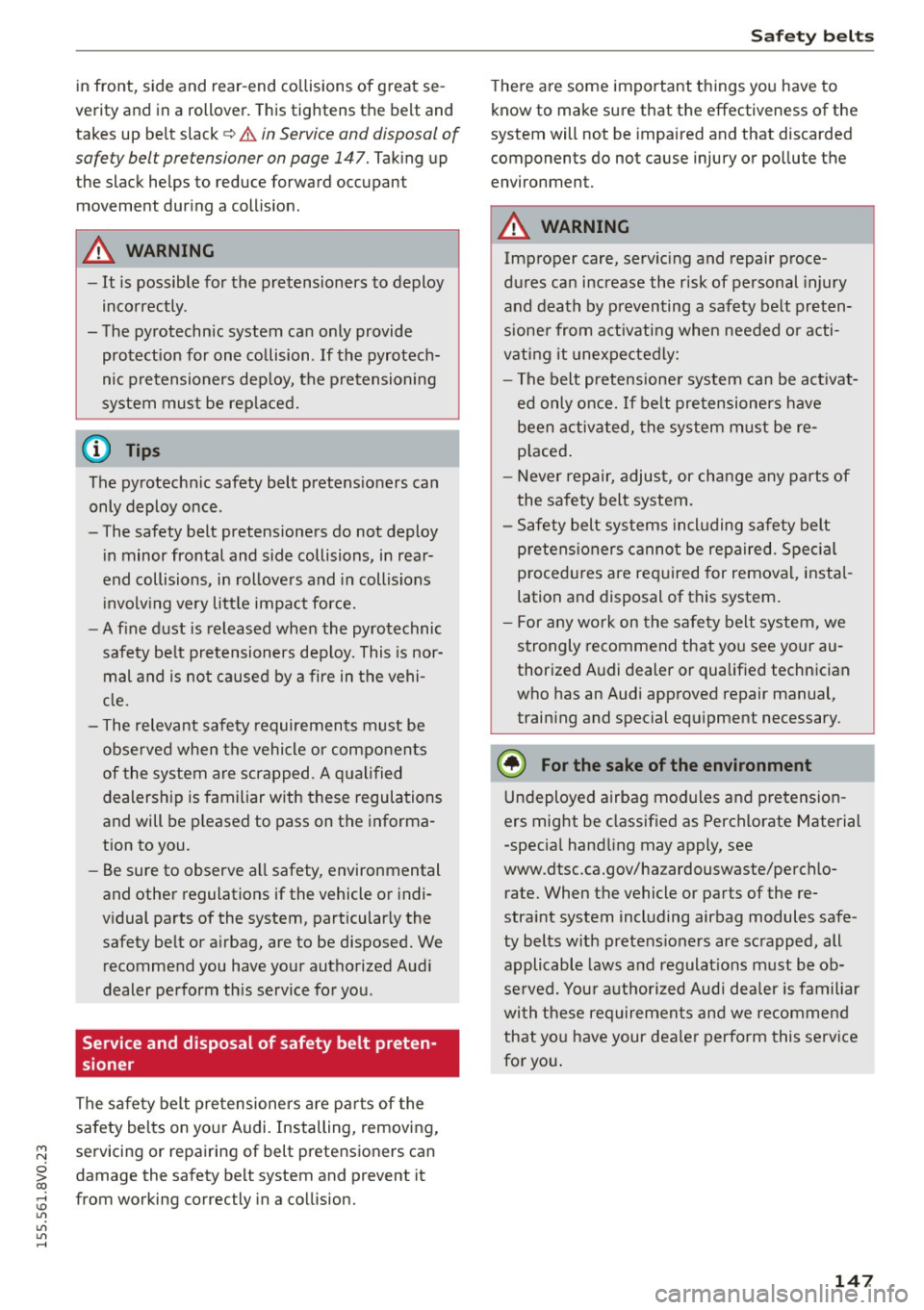
M N
0 > co ,...., \!) 1.1'1
1.1'1
1.1'1
,....,
in front, side and rear-end collisions of great se
verity and in a rollover. This tightens the belt and
takes up belt slack¢.&.
in Service and disposal of
safety bel t pretensioner on page 147.
Taking up
the slack helps to reduce forward occupant movement during a collision.
A WARNING
- It is possible for the pretensioners to deploy
incorrectly .
- The pyrotechnic system can only provide protection for one collision . If the pyrotech
nic pretensioners deploy, the pretensioning
system must be replaced.
(D Tips
The pyrotechnic safety belt pretensioners can
only deploy once .
- The safety belt pretensioners do not deploy
in minor frontal and side collisions, in rear
end collisions, in rollovers and in collisions
involving very little impact force.
-A fine dust is released when the pyrotechnic
safety belt pretensioners deploy. This is nor
mal and is not caused by a fire in the vehi
cle.
- The relevant safety requirements must be
observed when the vehicle or components
of the system are scrapped. A qualified
dealership is familiar with these regulations
and will be pleased to pass on the informa
tion to you.
- Be sure to observe all safety, environmental
and other regulations if the vehicle or indi
vidual parts of the system, particularly the
safety belt or airbag, are to be disposed. We recommend you have your authorized Audi
dealer perform this service for you.
Service and disposal of safety belt preten
sioner
The safety belt pretensioners are parts of the
safety belts on your Audi. Installing, removing,
servicing or repairing of belt pretensioners can
damage the safety belt system and prevent it
from working correctly in a collision.
Safety belts
There are some important things you have to
know to make sure that the effectiveness of the
system will not be impaired and that discarded
components do not cause injury or pollute the
environment.
A WARNING
= -
Improper care, servicing and repair proce
dures can increase the risk of personal injury
and death by preventing a safety belt preten
sioner from activating when needed or acti
vating it unexpectedly:
- The belt pretensioner system can be activat
ed only once. If belt pretensioners have
been activated, the system must be re placed.
- Never repair, adjust, or change any parts of
the safety belt system.
- Safety belt systems including safety belt
pretensioners cannot be repaired. Special
procedures are required for removal, instal
lation and disposal of this system.
- For any work on the safety belt system, we
strongly recommend that you see your au
thorized Audi dealer or qualified technician
who has an Audi approved repair manual,
training and special equipment necessary .
@ For the sake of the environment
Undeployed airbag modules and pretension
ers might be classified as Perchlorate Material
-special handling may apply, see
www.dtsc.ca.gov/hazardouswaste/perchlo
rate. When the vehicle or parts of the re
straint system including airbag modules safe
ty belts with pretensioners are scrapped, all
applicable laws and regulations must be ob
served. Your authorized Audi dealer is familiar
with these requirements and we recommend
that you have your dealer perform this service
for you.
147
Page 150 of 282
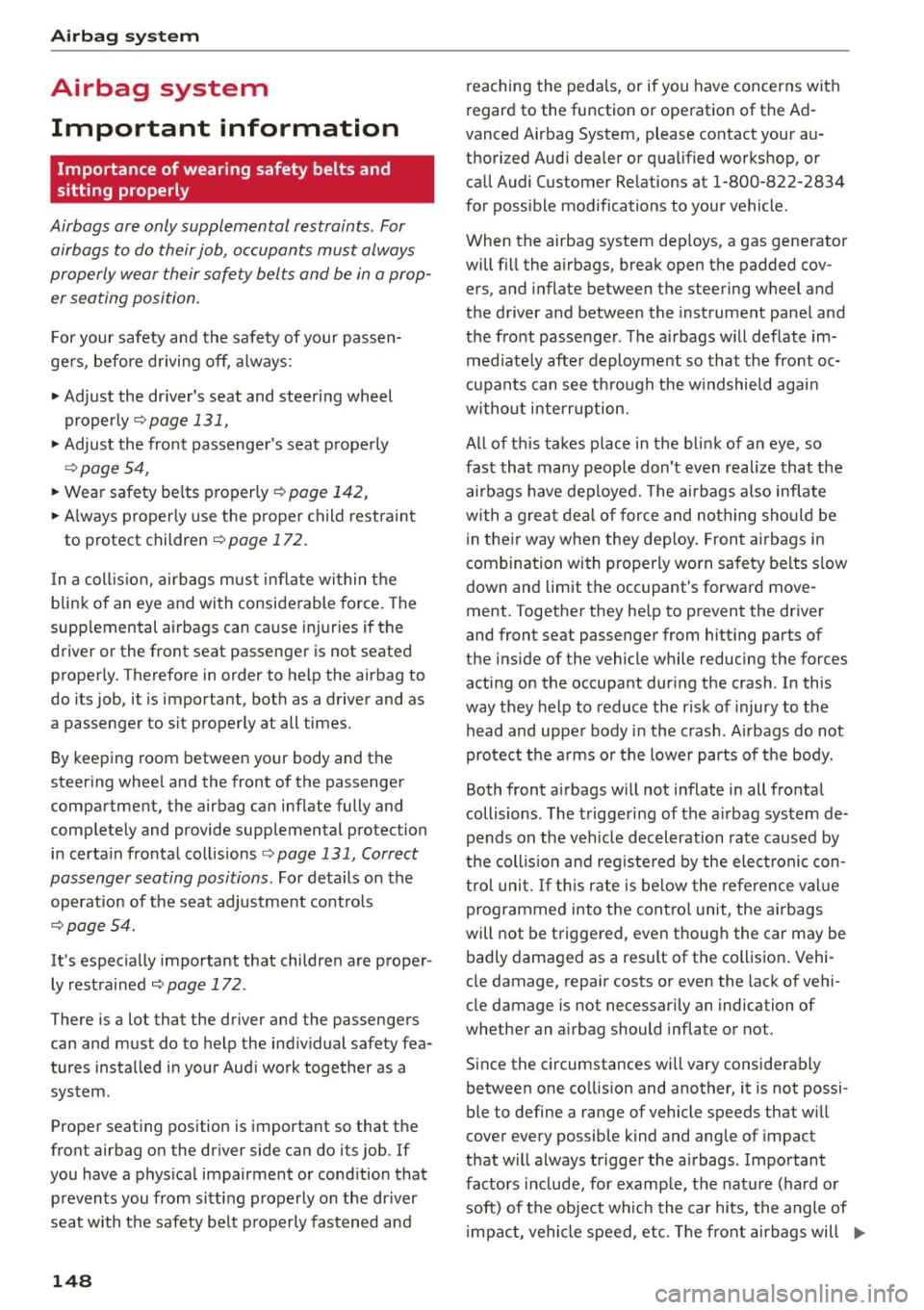
Airbag system
Airbag system
Important information
Importance of wearing safety belts and
sitting properly
Airbags are only supplemental restraints . For
airbags to do their job, occupants must always
properly wear their safety belts and be in a prop er seating position.
For your safety and the safety of your passen
gers, befo re driving off, always:
"' Adjust the driver's seat and steering wheel
properly
Q page 131,
"'Adjust the front passenger's seat properly
Qpage 54,
"'Wear safety be lts properly C? page 142,
"'Always properly use the proper child restraint
to protect children
Qpage 172.
In a coll is ion, airbags must inflate within the
blink of an eye and with considerable force. The
supp lemental airbags can cause injuries if the
driver or the front seat passenger is not seated
properly . Therefore in order to he lp the airbag to
do its job, it is important, both as a driver and as
a passenger to sit properly at all times.
By keeping room between your body and the
steering whee l and the front of the passenger
compartment, the airbag can inflate fully and
completely and provide supplemental protection
in certain frontal collisions
c> page 131, Correct
passenger seating positions.
Fo r details on the
operation of the seat adjustment controls
c>page54.
It's especially important that children are proper
ly restrained
Qpage 172.
There is a lot that the driver and the passengers
can and must do to help the individual safety fea
tures installed in your Audi work together as a
system .
Proper seat ing position is important so that the
front airbag on the driver side can do its job. If
you have a phys ical impairment or condition that
prevents you from sitt ing properly on the dr iver
seat with the safety be lt properly fastened and
148
reaching the pedals, or if you have concerns with
regard to the function or operation of the Ad
vanced Airbag System, please contact your au
thori zed Audi dea ler or qualified workshop, or
call Audi Customer Relations at 1-800-822-2834
for possible modifications to your vehicle.
When the airbag system dep loys, a gas generator
will fill the airbags, break open the padded cov
ers, and inflate between the steering wheel and
the driver and between the instrument panel and
the front passenger . The air bags w ill deflate im
med iate ly after deployment so that the front oc
cupants can see through the windshield again
without interruption.
All of th is takes place in the blink of an eye, so
fast that many people don't even realize that the
a irbags have deployed. The airbags also inf late
with a grea t deal of force and nothing should be
in their way when they dep loy. Front airbags in
combination with properly worn safety belts s low
down and limit the occupant's forward move
ment . Together they he lp to prevent the driver
and front seat passenger from hitting parts of
the inside of the vehicle while reducing the forces
acting on the occupant during the crash . In this
way they help to reduce the risk of injury to the
head and upper body in the crash . Airbags do not
protect the a rms or the lower parts of the body.
Both front a irbags w ill not inflate in all fronta l
collisions . The triggering of the airbag system de
pends on the veh icle deceleration rate caused by
the collis ion and registered by the electronic con
trol unit. If th is rate is below the reference val ue
programmed into the control unit, the airbags
will not be triggered , even though the car may be
badly damaged as a result of the collision . Vehi
cle damage, repair costs or even the lack of vehi
cle damage is not necessarily an indication of
whether an a irbag should inflate or not.
Since the circumstances will vary considerably between one co llision and another, it is not possi
ble to define a range of vehicle speeds that will
cover every possible kind and angle of impact
that w ill always trigger the airbags . Important
factors include, for example, the nature (hard or
soft) of the object wh ic h the car hits, the angle of
i mpact, vehicle speed, etc. The front airbags will .,.